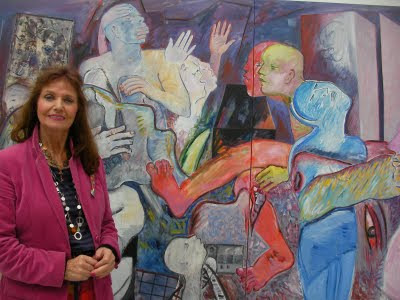Ann Shaw talks to Andrew Bryant about working in the virtual realm, her career development from journalist to artist, and current concerns.

'"Forgotten"', digital. Centre for Older Adults, Chicago.
Andrew Bryant: You had a previous career as a journalist. What made you
switch to art and how difficult was the transition? Ann Shaw: I come from Wales and in those days it was unheard of for anyone
to go to art college – you either went to university or teacher training college.
When I moved to Scotland I found myself for the first time in a country with a
strong visual culture. This allowed me to renew my interest in art by going to
evening classes, weekend courses, holiday courses and even a masterclass
with Eduardo Paolozzi. I switched to job-sharing so that it would give me more
time to practise my art and I had a WASP studio, though I was aware that I
needed art school training.
Leaving the security of a very well paid job, which I thoroughly enjoyed, for the
insecurity of life as an artist took me several years to resolve. In the end my
desire to make art won through. I had by this time already started exhibiting
work, but it was very much a hit and miss affair. I knew that in order to progress
I needed both the training and the official stamp of approval of an art degree. So
I took voluntary redundancy from The Glasgow Herald (as it was known then)
and started a four-year, full-time course at Glasgow School of Art. Once inside
art school it became obvious that there were many different strands to art. A
year in Chicago on exchange to The School of the Art Institute opened even
more doors (especially digital video and performance).

'"The Waiting Game"', Digital. Ann Shaw says:" This was taken in Mexico after visiting some Mayan ruins. The juxtaposition of the iguana and the couple caught my eye."
AB: Francis Alys trained as an architect and Susan Hiller had a previous life as
a sociologist. Both are high profile artists with major retrospectives at Tate. Has
your background as a journalist shaped the kind of artist you are? AS: I am curious to see your reference to Francis Alys and Susan Hiller, whose
work I greatly admire. In my own case I found that I was not taken seriously as
an artist because I was already known as a journalist (in art school I reckon I
got an extra tough time because of it). I think it’s only now, very late in life, that I
have the confidence to combine the two, to let the one feed off the other.
For a long time I tried to banish my background in journalism but now I realise
that it feeds into my current practice more and more. For example I am working
on a project ‘The Time of Our Lives’ which challenges our stereotyped image of
our ageing population. Because of my journalistic background and contacts I find
it very easy working with people. In fact I seem to be moving more and more
towards ‘social sculpture’ where the interaction between people and their
contribution becomes greater than the finished film. Having said that I have
recently gone back to a life drawing class in order to get back in touch with the
special kind of magic of putting marks on paper – something lost in computers.

Ann Shaw, '"Strong"', digital.Inspired by Moodscope.com the free online testing kit which analyses your daily emotional state.
AB: Your blog is currently concerned with preparations for the Forth Valley Open
Studios. Open studios raise the hoary old question of putting a price on art.
AS: There are many different threads to art and one of the things that organising Open Studios has taught us is that there is a role for all. Studios are not vetted. We let the public decide."

































